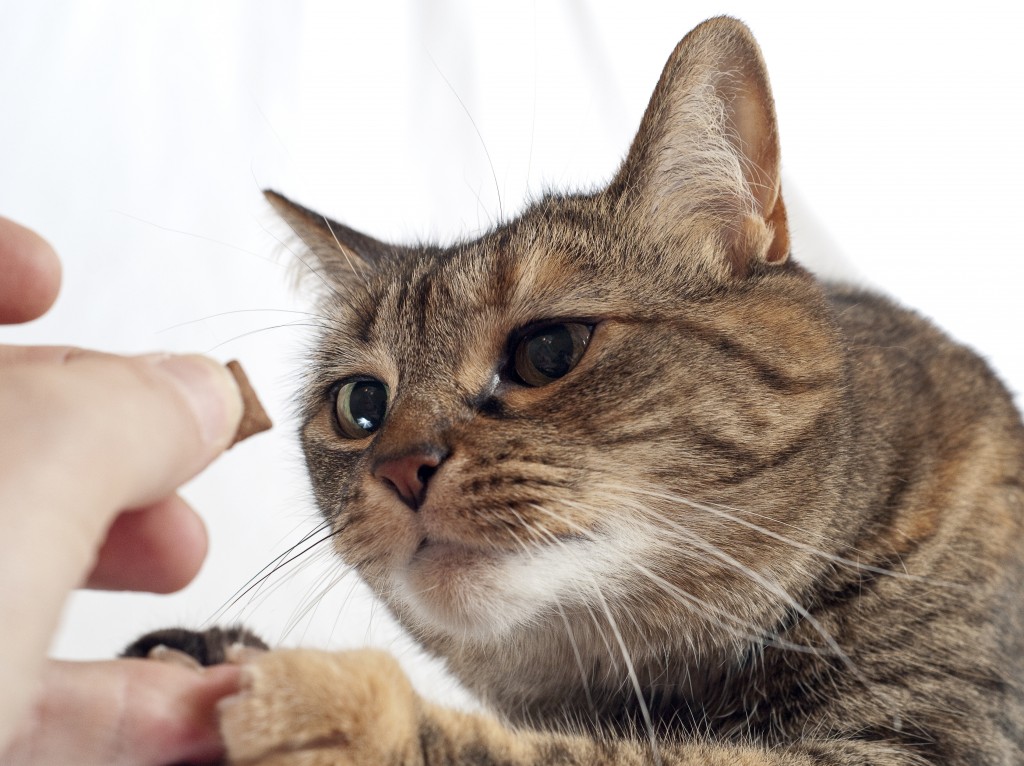
You know how people say that cats can’t be trained? I will heartily disagree with that statement! In fact, cats have got this training concept down pat. Think about it – they’ve already got YOU trained to respond to their every whim – they meow, you give them food. They jump on your lap, they get pets. They know just how to get what they want from you, because they know that you will respond to their reward: the love they give you in return. Ok, so I’m anthropomorphizing just a little bit, but basically it’s true – you are trained to respond to your cat’s demands. The motivation is your cat’s affection. You are positively reinforced by doing good things for your cats, so you do those things again, and again, and again.
The same thing applies to you training your cat…you just need to find out what motivates her. Luckily, many cats are food-motivated (i.e., they like treats), which is a fine reward to use in many cases. For cats who don’t respond so much to food, you can always use affection or sweet-talk as a reward, or even a short play session. Finding out what your cat likes and will respond to is key to using positive reinforcement!
So, what exactly is positive reinforcement? There are two parts: first, the positive part. Positive in this case means that something is added (as opposed to removed, which is negative) or given to the cat. Second is the reinforcement part. Reinforcement means that you’re doing something to encourage the repetition of a particular behavior (whereas punishment is the opposite of that – when you do something to inhibit the behavior from happening again). So, if you give a cat a treat because she used the scratching post, that’s positive reinforcement. Your cat is happy, she begins to associate the scratching post with good things (treats), and she starts using the scratching post more often. On the other hand, positive punishment is just about the worst thing you can do – you give the cat a swat (this is positive, because you are doing something to the cat) in hopes of her not scratching the furniture. Unfortunately, you’ve done two things: first, you’ve just created stress between you and your kitty, which can erode your relationship, and second, you haven’t shown your cat an appropriate outlet for her behavior – you’ve just told her what not to do, which she likely won’t link to the swat she just received (she won’t know why you just swatted her).
This being the case, I ALWAYS focus on positive reinforcement to help cats establish better habits in the home, and I never encourage punishment. Cats really don’t respond well to punishment on a stress-level side side of things, and they have a hard time associating the behavior with the punishment. They respond so much better to positive reinforcement!
So what can you use positive reinforcement for? Nearly anything! Let’s say your cat likes to drink out of your cup of water with her paw and it’s getting a bit tiresome. All you need to do is provide her with her own cup in an acceptable location (for you and the kitty), and when she goes for your glass, simply move her to her cup in a very neutral way, and then give her a treat/pets/affection/sweet talk when she uses her cup.
Another example? Counter-surfing! Cats love to be up where they can see what you are doing, especially when it comes to preparing food. While you may have to use some form of aversion training to keep the kitties off the counter while you’re not in the room (I always recommend sheets of cardboard covered with double-sided sticky tape that you can put on the counters when you’re not working in the kitchen), it’s fairly easy to reward good behavior. You’ll need to have a place that is acceptable for your cat to be so that she can see what you’re working on. Many people have a designated stool or cat tree that they put right next to the counter. If the kitty jumps up on the counter, remove her gently (and neutrally), put her on the floor, then coax her to the stool or cat tree with a treat. When she is seated on the stool, give her a reward. She’ll soon begin to understand that she gets treats on her stool, and nowhere else!
A word of caution, though – make sure you are rewarding the correct behavior. In the example above, don’t just move your cat from the counter to the stool, then give her a treat – if you do that, you’ll have just rewarded your cat for jumping on the counter. You need to have an interruption between the undesirable behavior and the acceptable behavior.
You can reward good general behavior, too. If your kitties aren’t getting along very well, reward calm behavior when the two are together. If your cat keeps you up at night with meowing or activity, you can reward calm, quiet behavior. And let’s not forget about clicker-training – with a clicker, you can teach your cat to associate the sound of the clicker with a treat, so that the clicker sound eventually becomes the reward! Your cat will work to make the clicker click, and with that enhanced ability to communicate, you will be amazed at what your cat can learn to do.
Positive reinforcement is a great way to improve the bond between you and your cat, and let her know which behaviors are favored. It’s another tool in the cat behaviorist’s toolbox that I’m happy to share with you…now get up and give your cat a reward for letting you read this entire article! It’s just what she wants (see…she’s got you trained already)!

